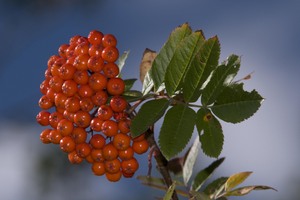Nature Column April 11, 2013
Rose Family
A dozen red roses is a sure way to extract myself from just about any callus or unfeeling faux pas I might commit at home. There is something about a bouquet of those stunning flowers that can melt even the most flint-hearted.
But roses, for which the family Rosaceae was named, are actually just a small part of a family with over 3,000 species, mostly from the Northern Hemisphere. If you are having trouble thinking of any other members of this family, take a look in your refrigerator or out in your backyard. Chances are good you have the fruit or a tree from a member of the Rosaceae family. Some of the more economically important species include: apples, pears, cherries, peaches, plums, apricots, almonds, strawberries, blackberries, and raspberries.
And these are just the edible ones. Besides roses, ornamental rose family members include landscaping favorites such as: pyracantha, cotoneaster, spirea, potentilla, crabapples, and flowering versions of cherries and pears.
Members of the rose family can be herbs, shrubs or trees. Most species are deciduous, but some are evergreen. Rosaceae generally have five sepals, five petals, and contain both male and female floral structures. The bases of the sepals, petals, and stamens are fused together to form a cup-like structure called a hypanthium (the edible part of an apple is the hypanthium). Fossil evidence suggests that this family has been in existence for at least 35 million years, but the one thing you still won’t see is a blue flower on a member of this family: they lack the genetic ability to produce one.
And the rose family is important to wildlife as well. I have flushed a dozen ruffed grouse from a single mountain ash and watched hundreds of cedar waxwings mob berry rich hawthorn trees. The chokecherries in my backyard are always loaded with berries, but they rarely get the chance to ripen before robins devour them. I have planted tens of thousands of bitterbrush for deer and elk to munch on during the winter, and I have failed in attempts to establish dogwoods because the moose could not leave them alone. Thickets of wild rose or blackberry provide outstanding cover along with a food source for grouse, rodents, and rabbits. In our part of the world, wildlife would have a pretty tough go of it without the rose family.
Fruit production is a hallmark of many species of the rose family. It might seem like an extravagance, but is really part of an evoutionary strategy to aid in seed dispersal. The plants depend on the animals to consume their seeds along with the fruit. When the animal defecates, many of the seeds are discharged, fertilizer and all, into new habitats. Both the plant and the animal win.
A great thing about the rose family is that many of the wild plants can be grown in your yard and do double duty as wildlife friendly and ornamentally pleasing landscape plants. Even with my brown thumb, I am able to grow chokecherry, serviceberry, bitterbrush, mountain ash, and strawberries in the wild side of my backyard. They are beautiful and the wildlife, particularly birds, loves them. I always look forward to spring when their blooms brighten my world.
By Terry Thomas
Terry is a wildlife biologist with 26 years experience.

Ash berries like these provide high calorie nourishment for wildlife. In return, the animals deposit the seeds in new locations, benefiting the plant.